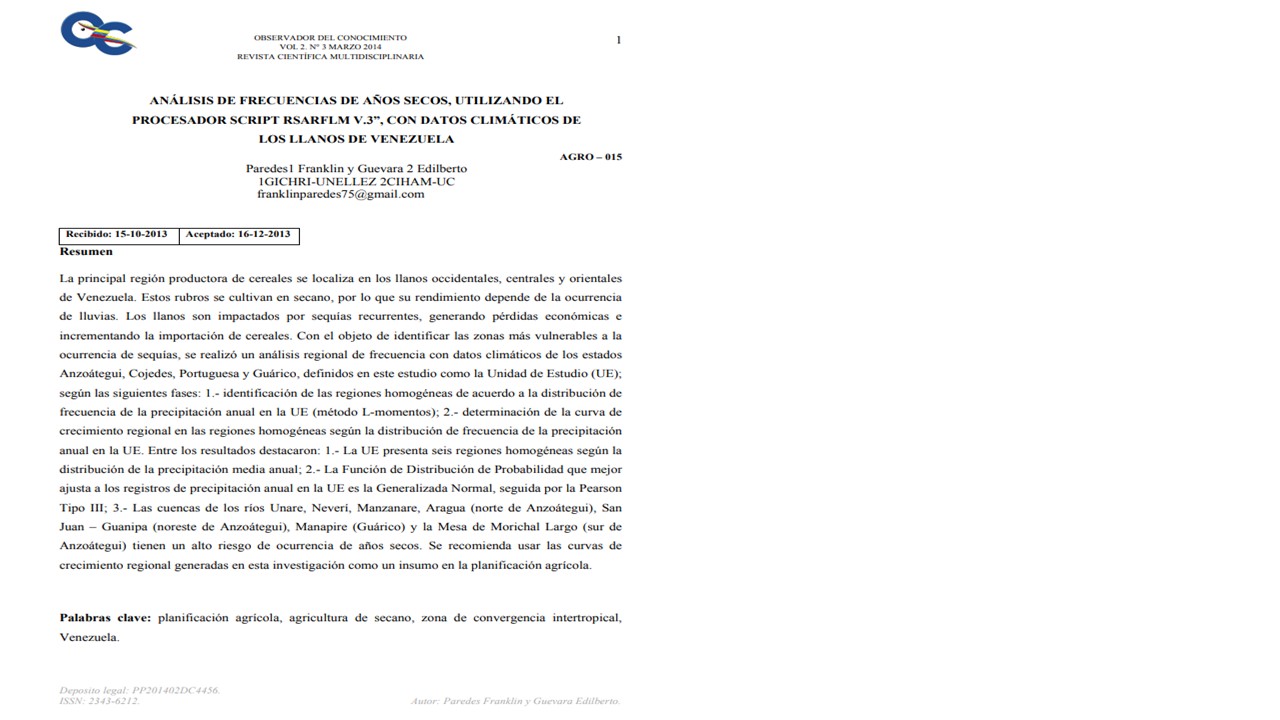Analysis of Dry Year Frequencies, Using The Script Rsarflm Processor v.3 ", With Climatic Data From The Llanos de Venezuela
Keywords:
Agricultural planning, rainfed agriculture, intertropical convergence zone, VenezuelaAbstract
The main cereal producing region is located in the western, central and eastern plains of Venezuela. These crops are grown in dry land, so their yield depends on the occurrence of rainfall. The plains are affected by recurrent droughts, generating economic losses and increasing the importation of cereals. In order to identify the areas most vulnerable to the occurrence of droughts, a regional frequency analysis was carried out with climatic data from the Anzoátegui, Cojedes, Portuguesa and Guárico states.
Downloads
References
Álvarez, M.; Puertas, J.; Soto, B.; Díaz- Fierros, F. (1999). Análisis regional de las precipitaciones máximas en Galicia mediante el método del índice de avenida. Ingeniería del Agua. 6(4): 283-290.
Easterling, R.; Peterson, C.; Karl, T. (1996). On the development and use of homogenized climate data sets. Journal of Climate (9): 1429-1434.
El Universal. (2012). Venezuela: producción de cereales está a 50% de lo registrado en 2007.
Guttman, N. (1993). The use of L-Moments in the determination of regional precipitation climates. Journal of Climate. 6(12): 2309-2325.
Guttman, N.; Hosking, J.; Wallis, J. (1993). Regional precipitation quantile values for the continental UnitedStates computed from L-Moments. Journal of Climate. 6(12): 2326-2340.
Hallack-Alegria, M.; Ramirez- Hernandez, J.; Watkins, D. (2011). ENSO-conditioned rainfall drought frequency analysis in northwest Baja California, Mexico. International Journal of Climatology. Published online in Wiley Online Library
Hallack-Alegria, M.; Watkins, D. (2007). Annual and warm season drought intensity-duration- frequency analysis for Sonora, Mexico. Journal of Climate. 20 (9): 1897–1909.
Helsel, D.; Hirsch, R. (2002). Statistical methods in water resources. USGS, Book 4, Hydrologic Analysis and Interpretation, Chapter 3. 250 pp.
Hosking, J.; Wallis, J. (1997). Regional frequency analysis: an approach based on L-moments. Cambridge University Press, Cambridge, U.K. 224 pp.
Hosking, J.; Wallis, J. ( 1993). Some statistics useful in regional frequency analysis. Water Resources Research. 29(2): 271-281
Kassen, F. ( 2009). El arroz en Venezuela. Memorias, [CD-ROM] Primer Foro Arrocero Venezuela 2009. Acarigua, Venezuela
Núñez, J.; Verbist, K.; Wallis, J.; Schaefer, M.; Morales, L.; Cornelis, W. (2011). Regional frequency analysis for mapping drought events in north-central Chile. Journal of Hydrology. (405) 3–4: 352–366.
Núñez, J. (2011). RSARFLM v.3. Regional Frequency Analysis L-moments R Script. Water Center for Arid and Semiarid Zones of Latina America and the Caribbean. CAZALAC. La Serena, Chile
Pérez, C. ( 2004). Técnicas de análisis multivariante de datos: aplicaciones con SPSS. Pearson Prentice Hall, Madrid. 672 pp.
Štěpánek, P. (2003). AnClim - software for time series analysis. Department of Geography, Facultad of Natural Sciences, MU, Brno. 1.47 MB.
Tallaksen, L.; Hisdal, H. (1997). Regional analysis of extreme streamflow drought duration and deficit volume. In: Gustard, A., Blazkova, S., Brilly, M., Demuth, S., Dixon, J., Van Lanen, H., Llasat, C., Mkhandi, S., Servat, E. (Eds.), FRIEND’97- Regional Hydrology: Concepts and Models for Sustainable Water Resource Management, Ed. IAHS Publication 246:141–150.
Tallaksen, L.; Hisdal, H. (1999). Classification of methods of regional drought streamflow series: the EOF method and L-moments. Technic Report No. 2, [en línea]. Recuperado el 18 de Julio de 2009, de http://www. hydrology.uni- freiburg.de/forsch/aride/ navigation/publications/ publications. htm.
UNESCO. (2010). Guía metodológica para la aplicación del análisis regional de frecuencia de sequías basado en l-momentos y resultados de aplicación en América Latina. Documento Nº 27 publicado por el Programa Hidrológico Internacional (PHI) de la Oficina Regional de Ciencia para América Latina y el Caribe de la Organización de las naciones Unidas para la Educación, la Ciencia y la Cultura (UNESCO). Montevideo, Uruguay. 87 pp.
Wallis, J.; Schaefer, M.; Barker, B.; Taylor, G. (2007). Regional precipitation-frequency analysis and spatial mapping for 24-hour and 2-hour durations for Washington States. Hydrology Earth System Science. 11(1): 415-442.
Yurekli, K.; Anli, A. (2008). Analyzing drought based on annual total rainfalls over Tokat province. International Journal Natural Engineering Science. 2(2): 21–26.

Downloads
Published
How to Cite
Issue
Section
License

This work is licensed under a Creative Commons Attribution-NoDerivatives 4.0 International License.







